Putin has arrived in Beijing for what is a momentous meeting:
Not only is it the symbolic first foreign trip of his latest presidential term, but digging under the hood, we discover there is even much more import to the trip to distinguish it from the merely routine.
Firstly, Putin brought virtually every major figure of the Russian government with him, most notably new Defense Minister Belousov—though Shoigu remained significantly at his side:
This has led many pundits to analyze the trip on a deeper level than usual.
This thread by a Ukrainian reserve officer lists the following entourage:
Furthermore, key representatives of businesses and oligarchs are part of the expanded delegation.
- Oleg Deripaska, oligarch and founder of RUSAL
- Igor Sechin, oligarch, CEO of Rosneft
- Herman Gref, Chairman of Sberbank's Executive Board
- Andrey Kostin, President-Chairman of VTB Bank
- Kirill Dmitriev, CEO of the Russian Direct Investment Fund
- Leonid Mikhelson, Chairman of NOVATEK
- Igor Shuvalov, Chairman of VEB.RF
- Alexander Shokhin, President of the Russian Union of Industrialists and Entrepreneurs (RSPP)
That’s in addition to Lavrov, Peskov, Shoigu, Belousov, and others.
That is a full house, and represents major deals being formed. The Ukrainian officer agrees:
Such a list of decision-makers from the financial and economic sectors suggests that this delegation is not ordinary but rather an ambitious and serious effort to deepen economic and financial cooperation with China.
Given the presence of the newly appointed Minister of Defense and the Director of the Federal Service for Military-Technical Cooperation, we should also anticipate discussions on military-industrial cooperation. This should not be dismissed as a routine event.
The last time Shoigu visited North Korea, Russia received millions of artillery shells and ballistic missiles. However, unlike that delegation, this one is heavily represented by the financial and economic sectors, suggesting Russia's serious intent to address economic and financial problems caused by war.
Read not only the bolded, but the last paragraph above.
There are other indicators and rumors that Russia, specifically, will be making some sort of major drone-tech related partnerships.
Arnaud Bertrand sums up some of the most significant details:
Read his elucidating thread, with key points being:
Building a new world order, consisting of:
And:
Russia and China are truly shaping up to lead the world together through the adolescence of this century, reshaping the international order into one based on real principles rather than the fraudulently imagined crony “rules based order” trap of the dying Anglo-American Empire.
—
The other most significant event was Putin’s speech in front of his cabinet council, which debuted Belousov and Shoigu in their new positions:
Also note General Lapin’s prominent position at Belousov’s side: Lapin is said to be the commander of the new Leningrad district, whose units—according to some reports—comprise the majority of active fighters on the new northern Kharkov front.
In the speech, Putin makes an important concession, which is a little lost in the AI translation above. In essence, he admits that Russia—like everyone else in the world—did not fully know what they were doing in the beginning of the SMO. Most likely he’s referring to anticipating some of the drone developments, primarily.
“Many things were not clear to us at the beginning of the SMO. Not to us nor anybody.”
The other hugely important point is two-fold. Firstly, he reinforces our earlier reports that the hiring of Belousov is entirely centered on managing the Russian economic integration of the defense and civil fields.
As you can see from the quote above, Putin is prioritizing the health of the country’s overall economy. In short: Belousov’s job is to make sure that the long-term economic repercussions of the military conflict do not adversely affect the general economy and civilian life.
He emphasizes this point by bringing up the next big ‘bombshell’: Russia’s combined defense and security spending is already approaching 9% of GDP, while that of the Soviet Union’s in the 1980s was north of 13%. Here’s just that clip:
This is obviously a quite staggering number that no country on earth currently spends. That means Putin recognized Russia is slowly drifting into the danger zone and no pains must be spared in competently managing these economic forces. No man, by all accounts, appears better suited to this than Belousov. I’ve seen several former Western colleagues of his now laud him with praise.
Here’s one of the latest examples, whose very revealing thoughts are worth reading; French economist Jacques Sapir:
Andrei Belousov has just been appointed Minister of Defense. It's an important appointment both because of the man and because of what it means politically. #Thread on this subject.
I've known Andrei Belousov since the early 1990s. At the time, he was a brilliant research director at the Institute for Economic Forecasting and took part in the first Franco-Russian seminar sessions held in Moscow.
To call him a "liberal" is misleading. He was "liberal" in the sense that he had noted the bankruptcy of Soviet central planning and was in favor of privatization, but so were all of us at the FR seminar!
In 1995-1996, he was shocked and scandalized by the situation in Russia and the collusion with the oligarchs, and he was one of those who spoke to me about the need for a "healthy forces" reaction if the country was to be saved.
He was held in high esteem by the two successive directors of the IPE, and in particular by Victor Ivanter, who was the real director of the Institute from 1996 until his death in 2019, and who maintained that he was the only one to understand the concept of GDP.
He went on to set up the ROSSTAT reform and, in this capacity, I had further opportunities to meet him when I took part in the INSEE -ROSSTAT assistance program. He quickly earned the respect of our INSEE colleagues.
He joined the presidential administration at the end of 2000 when Putin was elected, and quickly became one of his advisors on the economy and innovation, putting all his skills (Economics and Math) to work in his new role.
It was at this time that I wrote 2 reports for the presidential administration (2002 and 2007), which were subsequently published in "Problemy Prognozirovanija", the IPE-ASR journal.
He understood (and understands) perfectly that Russia's survival depended on its economy AND its ability to develop an innovation regime that involved an entire ecosystem as well as a financing system.
He played an important role in drafting the legislation and regulations that enabled the development of techno-parks in conjunction with major universities such as Novosibirsk (the Franco-Russian seminar relocated one of its sessions there in 2015).
He joined the government as Minister of Economic Development (maintaining links with IPE-ASR). Even then, he was convinced that investment and the construction of large, innovative groups were the key to Russia's success.
Considering him as a planner only makes sense if we understand planning as the process implemented in France in the early 1960s or in Japan from 1957 to 1971. The aim is to guide the activities of public and private groups.
For too long, it was blocked by the Ministry of the Economy and Finance and the Central Bank. It was not until the COVID crisis (2020) that he was able to emancipate himself and begin implementing his ideas.
It was at this point that Belousov, who had also become Deputy Prime Minister, seems to have taken a turn for the better. In 2022 and 2023, he accompanied and coordinated the strong growth in investment by private companies and the resulting growth in the economy.
His appointment to the Ministry of Defense is of considerable importance. It marks the transformation of this ministry into a production, design, research and innovation agency for the armed forces.
The impact on military-industrial companies will be considerable. They will see their activities streamlined, and above all they will have to be attentive to the link between the short term and the long term through innovation processes.
This also means that a number of companies from techno-parks and start-ups will be integrated into this process to drive innovation. It is likely that Russia will set up an equivalent of DARPA to ensure civil/military contact.
The purely "military" functions of the Ministry could be placed under the authority of an enlarged General Staff, including those responsible for economic affairs, transport, intelligence, etc., on the model of the STAVKA of the Second World War.
This new STAVKA would then logically be attached to the Presidential Administration. We'll have to keep an eye on the news of this possible reorganization over the coming months.
Andrei Belousov is convinced that the development of military production MUST NOT be at the expense of civilian production. It's safe to assume that he will maintain the 40/60 ratio for military/civilian production.
However, his appointment indicates that the Russian government is looking far beyond the current hostilities, and expects a period of 10 to 20 years of "cold" confrontation with NATO countries.
He knows that in this logic, Russia's ability to resist, or even win, depends not only on military production alone, but also on the vitality of its economy and the innovation processes developing within it.
Read the last bolded part again:
“Andrei Belousov is convinced that the development of military production MUST NOT be at the expense of civilian production. It's safe to assume that he will maintain the 40/60 ratio for military/civilian production.”’
This is part of what Putin’s momentous trip to China may be all about. Putin has recently spoken specifically about “dual-use technologies”, which the Western media has picked up on in their new sanctions threats against China. This is likely what the above is referring to: Belousov will streamline efficiencies by pushing for a host of new dual-use manufacturing capabilities which can benefit both civilian and military sectors alike. The plus side to dual-use tech is it evades sanctions as it’s classified under civilian rather than military imports, but of course the U.S. and Europe are trying to crack down on that as we speak.
Also note about the long term outlook. Sure, it can be read that Russia expects this conflict to last a long time by virtue of these latest moves. However, it comes down to simple pragmatic thinking: whether it lasts long or not, Putin knows this is the wise step to take in order to ensure Russia’s future development. He’s had two years to accumulate data about the SMO: the failures, the successes, what is going well, what could be done better. Now, he’s merely acting on it irrespective of ‘future prospects’ for the SMO itself.
That being said, of course it’s possible that Ukraine will continue to hold out if their recruitment efforts are even moderately successful—and by the way, they have no choice but to be successful if enough coercion and duress is applied. I still maintain that the conflict has the highest chance to end by mid 2025 or so, but there is a chance it could go on well beyond that if certain things fall into place. I’ve said that, despite relatively high losses, Ukraine having gone on the defensive is still preserving its forces considerably better than before.
Think about this thought experiment: Ukraine has about 27 regions, that means each region has to produce about 1000 men per month. 1000 divided by 30 days comes down to about 30 men per day. That’s what each region needs to recruit to maintain overall strength of the AFU at around 30k recruits per month. In fact recently it may even be significantly lower than that. 30 men recruited per day from large regions amounts to just 4-5 men per town or less. That’s not exactly impossible.
That being said, as Russia stretches the front and opens up new directions, the losses could get truly unsustainable as there will be innumerable hotspots where AFU sustains manpower drains.
And on that note, Sumy rumors continue to flow.
The Ukrainian post claims Russia is bringing its equipment closer and closer to the line of contact on the Sumy border. Another new Reuters report likewise cites Sumy as an upcoming front:

Meanwhile, SkyNews gets alarmist over Zelensky’s urgency:

Other MSM articles continue the downbeat outlook:
The Economist even began to ominously remind people that Zelensky’s term soon officially expires:
Why would that be, one wonders?
—
On the front, Ukraine and the West celebrate the slowing of Russia’s northern advance. But this was expected, of course: the opening was always set to be fast until reserves were brought in. Now it will devolve into another bit of a grind, but will speed up in spurts as new cracks are formed and breakthroughs are found. Russia is still holding back the majority of its follow-on forces.
Several sources now report the vast patchwork of forces brought in to staunch the losses:
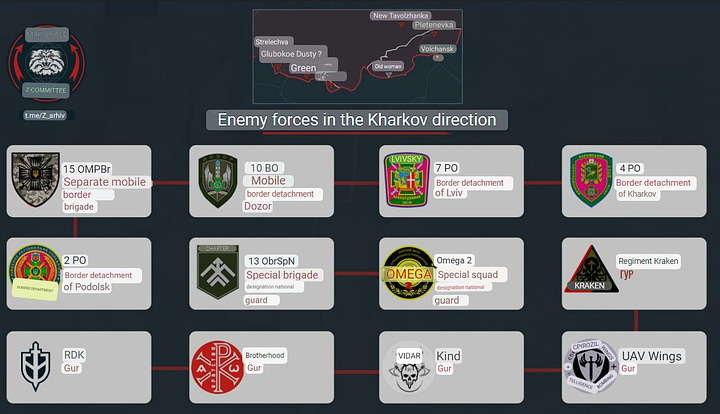
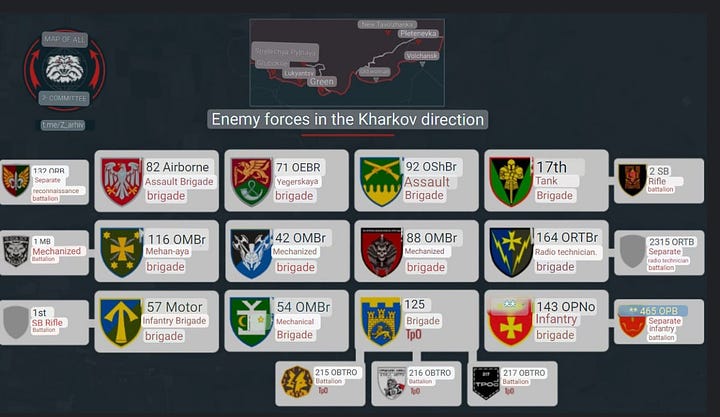
Most of them are just being skimmed from various units and do not represent whole, fully-staffed battalions.
One more exhaustive writeup reports the following units from both sides active on the Kharkov front:
According to the Pro-AFU Military land the units involved in Kharkov are the following.
****************************
Lyptsi direction:
****************************
Russian units:
- 9th motorized regiment
- 7th motorized regiment
- 79th motorized regiment
Ukrainian units:
- 42nd mechanized brigade
- "Omega Kharkov" of the national guard
- "Unit of Military institute of tank troops"
- Possibly the 113th defense brigade
****************************
Volchansk direction
****************************
Russian units:
- 153rd Tank regiment
- 138th motorized brigade
- 1st motorized regiment
Ukrainian units:
- 13th brigade of operational assignment Kharkiv
- 7th border detachment
- 82nd air assault brigade
- 1st rifle battalion, 57th motorized brigade
- Timur battalion of the GUR MO
- 117th assault battalion of the 57th motorized brigade
- 125th territorial defense brigade
- Belorussian volunteer corp
- Russian volunteer corps.
- possibly the 36h rifle battalion of 61st mechanized brigade
****************************
Notes
****************************
We know that the Krakenites are involved, but their location is not given.
- the anti aircraft missile unit based in Kharkov is also involved and being destroyed too.
The latest Suriyak maps have Volchansk about 20-30% controlled by Russian forces, give or take:
—
The other big update:
The past two days Ukraine launched two consecutive mass ATACMS attacks on the Belbek airbase in Crimea.
Russian sources claimed upwards of 10-16 ATACMS missiles were used, and that allegedly all but 1 or 2 were shot down. The ones not shot down wreaked significant damage, wiping out an entire S-400 unit, including launchers and highly expensive 92N6E Gravestone radar:
As well as a slew of Russian jets:
High res imagery from Belbek from Maxar tech have arrived.
1 destroyed Su-27(I think)
2 destroyed Mig-31(unknown iteration)
1 likely damaged Mig-29
The fuel depot was also obliterated.
The damaged mig-29, and possibly the destroyed jets could have been avoided with concrete bunkers
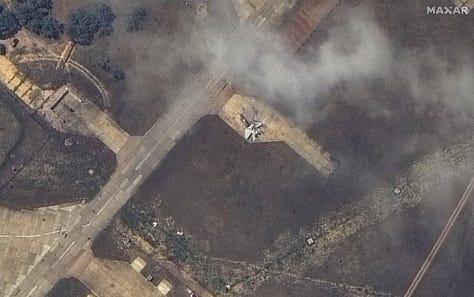
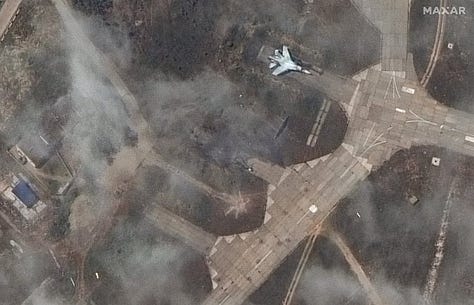
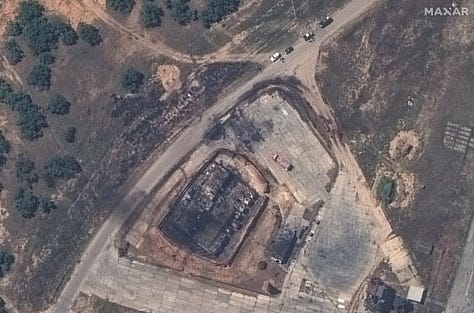
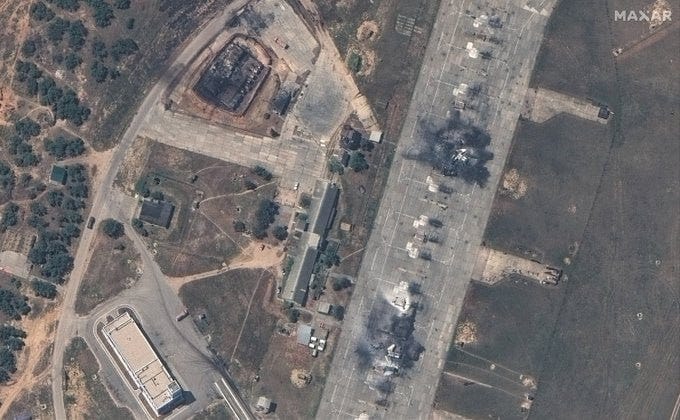
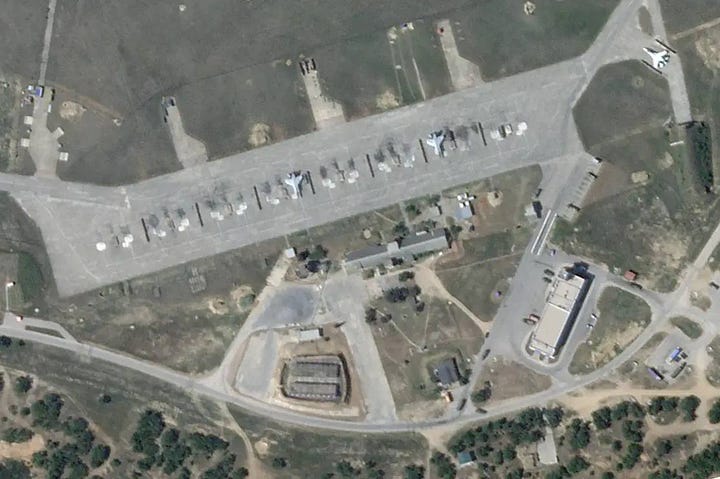
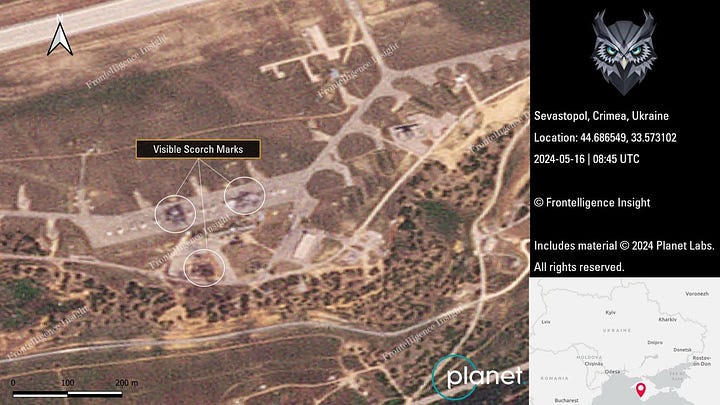
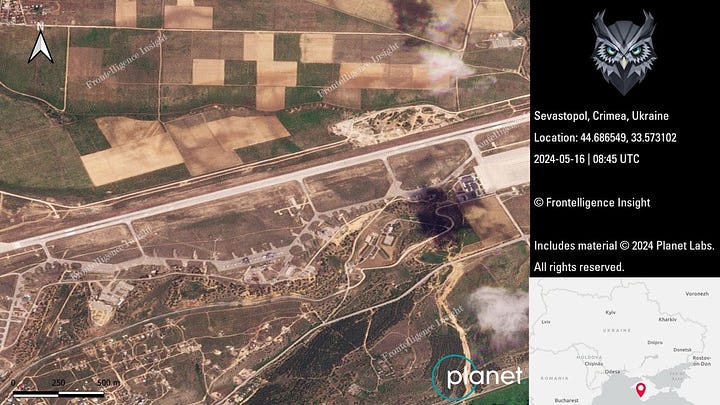
Now, let me emphasize: this is the only place on the internet where you will get a non-propagandistic take on such sensitive matters; you get both the good, bad, and the ugly with an unbiased analysis.
So let’s analyze it with a truly impartial and clear-sighted approach.
The first thing to note is that, I reported just a week ago on May 8th in this article that Russia had already begun moving its most important air assets out of reach, once ATACMS had begun being shipped in to Ukraine. Thus, whatever’s left within ATACMS range is generally speaking not the most important frontline fighters, but rather things like Su-27s and Mig-29s which are either not used at all, or used sparingly over the Black Sea, merely for recon or fight against drones, etc.
The exception of course is Mig-31s, which too are used for the purposes above, but they are far more valuable as Russia no longer builds them and has comparatively few remaining. Thus, the loss of multiple Mig-31s in the attack is a shocking act of carelessness on the Russian MOD’s part. For two years people have warned that hardened aircraft shelters are needed—these would easily stop the ATACMS cluster munitions, which cannot pierce any hardened surface. But for some reason, in this one area, the Russian MOD remains stubbornly lax.
Ukraine for reasons of absolute necessity has evolved to prosecute the war in a more defensively responsible and agile manner in terms of preserving its planes, lifting them up in the air at the first sign of attack. Russia, having a relative glut of planes, carries out operations a bit more carelessly without much concern if a portion of them are attritioned. Either that, or they were expecting the total superiority of Russia’s most advanced air defense systems over the ATACMS, which turned out to not be the case.
Although, it should be mentioned that it is suspected that some of the destroyed planes were in fact inoperative due to being old fuselages used for part transplants or merely undergoing repairs and unable to take off. There is some evidence of this: for instance some of the ‘destroyed’ Mig-29/Su-27s being positioned in the rear areas usually designated for inactive craft rather than positioned near the runways:
There are signs that some lone inoperative planes remained while the ones in the berths next to them had been scrambled out of danger.
Either way, the S-400 has proven to struggle with decisively stopping large-scale ATACMS saturations. This is the second S-400 in only a month that has been destroyed, the previous being in the north Crimean Dzhankoi base last month, which I posted about previously:
Keep in mind, some sources claim the attack featured other systems like French AASM Hammer missiles and other ‘decoys’, but this is difficult to believe given those missiles’ range is extremely short, and a Ukrainian plane would have needed to get right onto Crimea to launch them—which either way would represent a massive failure of Russian AD.
The struck Belbek base is too distant to reach by almost any other Ukrainian munition given its position at the southern tip of Crimea near Sevastopol, which is why the ATACMS is the only culprit. That’s not to mention ATACMS parts have been found all over the base, both the unexploded munitions as well as the discarded rocket stage:
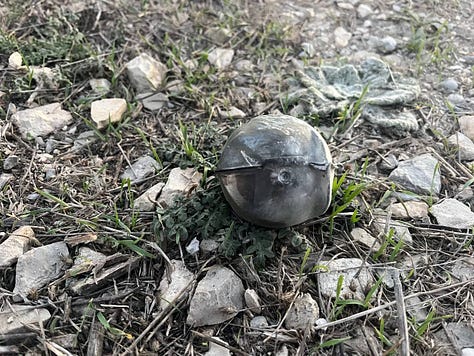
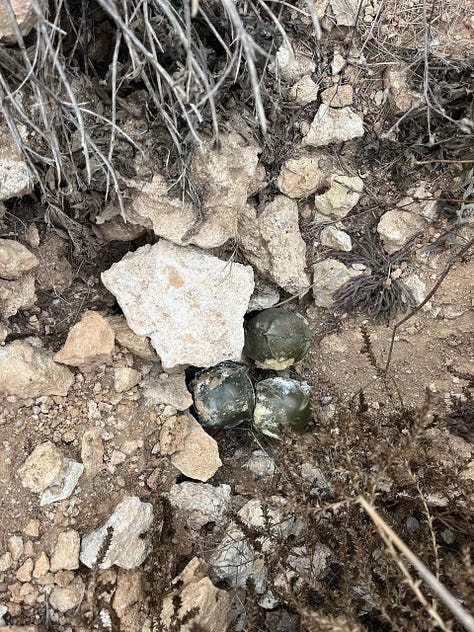
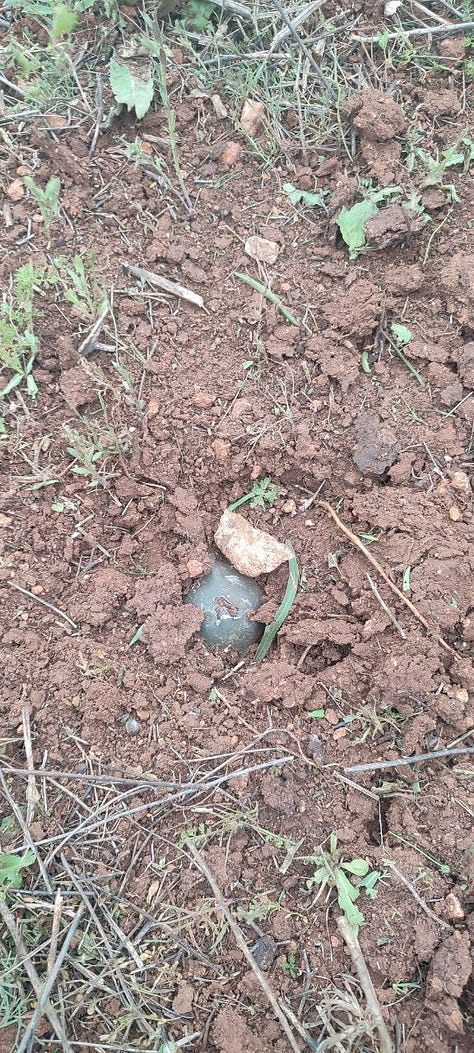
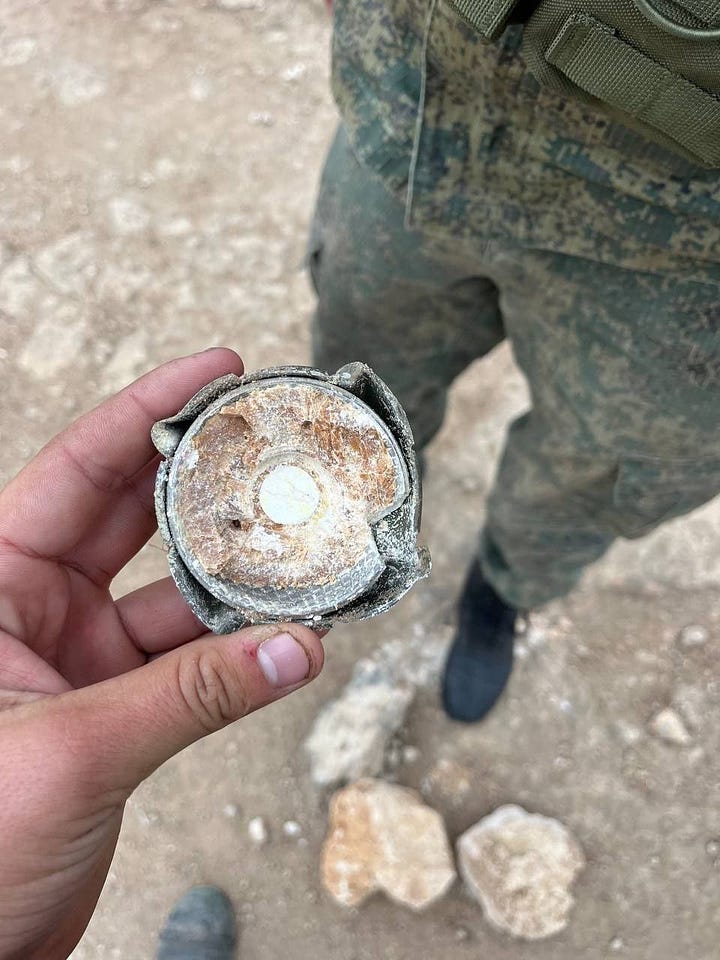
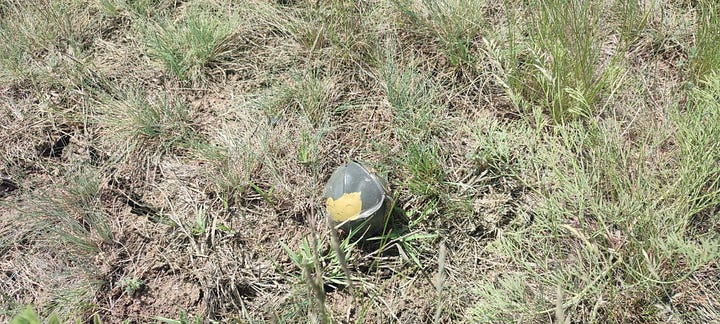
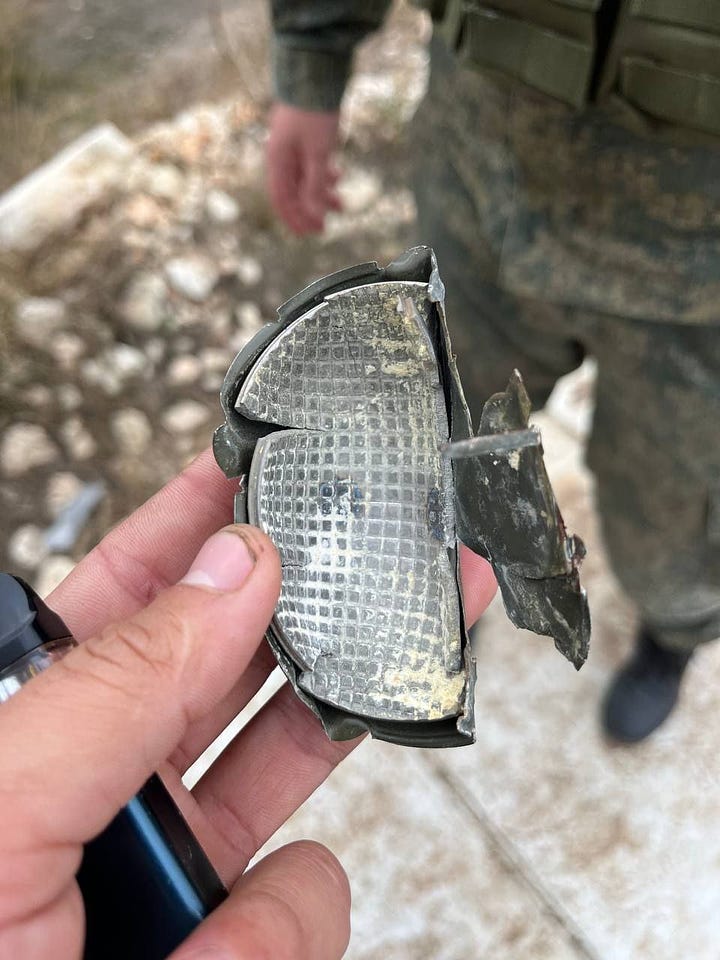
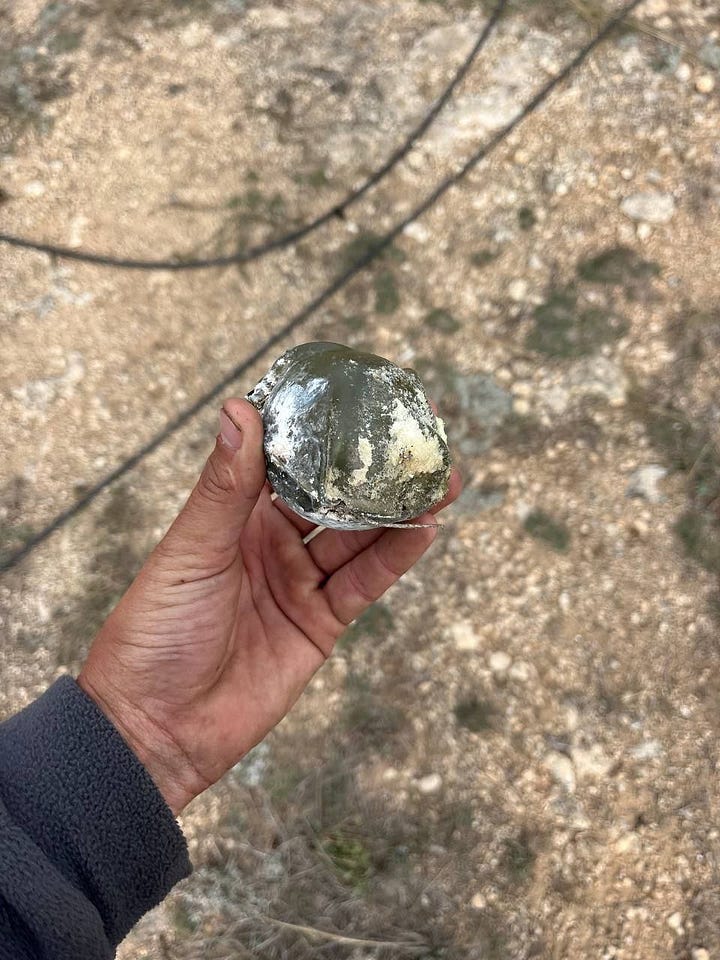
Note above I specified large-scale attacks. The S-400 did appear to shoot down a good number of them given that the damage to the base was limited to one relatively small area which corresponds roughly to the fragment “spread” of one or two ATACMS missiles.
Since many unexploded cluster munitions were found, particularly in areas claimed by Russia to be in villages far north of the Belbek base, it’s reasonable to assume many of the missiles were shot down. So it may still represent a respectable effort by the AD systems: shooting down the majority of incoming objects is a success. The real failure here is the inability to take precautions in protecting the planes, like building aircraft shelters.
As I wrote several reports ago, one thing is clear: no country on earth currently possesses the proven repeatable capability to convincingly stop ballistic missiles. Neither Russia, nor U.S. or Israel. Ballistic missiles, even non-hypersonic ones like the ATACMS, are proving to be an overmatch to all currently fielded anti-air systems. However, as I also have stated before, I do expect Russian capability to improve as they profile the ATACMS through more engagements then update their systems. Two "launchers” destroyed out of dozens of engagements where dozens of missiles were potentially shot down is still a respectable tradeoff.
Also, it should be noted that Ukraine launched a massive naval drone attack earlier as well, and that was entirely stopped by Russian naval forces, with most of the drones destroyed, and the few remaining scampering back toward Odessa. So it does show Russia is improving, which will likely happen with the ATACMS as well.
Lastly, here’s the most important takeaway:
Many pro-UA readers are rejoicing at this major Russian failure. But in fact, it represents a Ukrainian failure in the end.
Why?
Because Ukraine was provided only around 100 ATACMS for now, and they have now used roughly 25-30% of them attacking Russian targets of no strategic importance to the actual conflict, which will make no difference whatsoever in the war. Once again, the ATACMS are being used to create ‘high profile’ incidents meant to bolster Ukraine’s international image and morale, but which are doing nothing against the actual forces arrayed against them.
1. Crimea, as we already know, and as has even been admitted by MSM recently, is no longer even a transit point for Russian military arms. Crimea has little military relevance for the actual ground war happening all over Donbass, and particularly now in the north Kharkov region. To attack targets in Crimea does literally nothing at all for your war effort.
2. As I said, Russia has removed its most valuable assets from those bases: the Su-35s, Ka-52s—i.e. things which actually serve on the frontline and contribute to the war. The targets hit mostly represent AD systems—which, once again, merely guard the already strategically irrelevant area—as well as older jets used in secondary functions like surveillance around the Black Sea. Yes, the Mig-31s are a bit of an exception there. But given that ATACMS cost over $1M each per missile, 16 of them launched on a mostly irrelevant base is quite the frivolous expenditure to an extent.
In short: while a black eye on the reputation of Russian AD systems, such attacks serve no greater purpose than the much-celebrated hits on Russian ships months ago which we now can clearly see had zero effect on the war.
In fact, we can even conversely say that rather than having no effect, the strikes negatively effect the Ukrainian war effort because—as I wrote above—Ukraine is wasting its few precious ‘wunderwaffe’ on inconsequential strikes when those ATACMS could have been far better served hitting significant military targets like C2 nodes, ammunition sites, etc., in Russia’s rear somewhere closer to the actual front in Donbass.
At the same time as the strikes were ongoing, Russian Iskanders likewise rained down just a few miles away on Ukraine’s Nikolayev region, hitting several alleged ammunition warehouses, which are far more consequential targets for the ongoing ground war.
But even so: while these strikes will not have much effect on the real war for Ukraine, they should serve as a major alarm for Russia in regard to any future NATO conflict. The U.S. with its hundreds of HIMARS launchers and thousands of ATACMS missiles now understands Russia has no way of consistently stopping them, and is likely licking its chops. But remember—it goes both ways. The U.S. likewise has zero capability to stop Russian Iskanders, Kinzhals, and other missiles. That means in a slugfest between the two giants, neither would stop anything and pretty much would destroy each other’s rears at will. After that, it would come down to the grit of attrition war, which relies on manufacturing, morale, the mettle and starch of your human capital—and we already know who has the empirical advantage there.
Someone recently said this truism, paraphrasing: modern war will be all about offense, as defensive systems have not caught up in development to offensive ones. The winner will be the one who can pump the biggest “quantity” of offensive systems like drones onto the opponent.
And remember, MSM continues to highlight who’s got the technological edge in many of the most important fields:
As a last point:
Some take this AD failure to mean Ukraine now stands to easily destroy the Kerch bridge in the near future, since the S-400s clearly “can’t shoot down the ATACMS” missile.
I beg to differ.
Since the Russian AD has proven to shoot down the majority of them, I believe Ukraine does not stand a chance to get enough of the missiles past the AD net to critically wound the bridge. If Russia is shooting down 70-90% of the ATACMS in each batch, that means Ukraine may only get a few to hit, which is simply not enough to do anything beyond cosmetic damage.
Sure, they may add Storm Shadows and other things to the mix which will complicate the matter, but even so, despite what we’re seeing in Crimea, I remain fairly confident because the Kerch Bridge represents a far more complex target from a variety of angles.
In the end though it makes no difference: at most they can damage a few sections of the longest bridge in Europe, which Russia will easily replace in two months. It would have zero effect on the war, as always.
—
Last few interesting videos.
An unintentionally humorous interaction between Putin and Xi’s security detail during the visit:
Meanwhile, in a very rare sign of personal affection that goes beyond mere politics, President Xi went so far as to initiate a hug with Putin:
I call it the dragonbear hug, and it is symbolic of the historically close relationship Russia and China now enjoy.
To further underline this, Putin not only brought up the fact that the USSR was the first country to recognize China but recalled this popular Soviet song of brotherhood between the two people:
Lastly, in the NATO trophy exhibit, this Russian soldier became a shining example of humility when questioned about his numerous medals. He demurred by saying it was merely for loving his motherland, but it turns out the humble warrior was hiding the fact he was responsible for the destruction of multiple Leopards and Bradleys, amongst others:
Humble Russian soldier doesn’t want to tell his war stories.
-> He hit a Leopard and couple of Bradleys.
Here is his longer story: - On July 24 2023, near the village of Rabotino, Ivan quickly provided medical assistance to a wounded comrade and then evacuated him to a safe location.
- On July 26 2023, leading a Kornet anti-tank missile crew, Senior Lieutenant Zharsky took up a pre-prepared position and hit a Leopard 2A6 tank, causing its ammunition to detonate. After changing position, Ivan hit a Bradley IFV at close range, destroying its crew.
During the second wave of the enemy's assault, Zharsky's team skillfully destroyed six more BMP-2s in battle. As a result, the enemy retreated. (Video)
- On July 27 2023, the guardsmen continued to destroy enemy tanks and armored vehicles. Another Leopard tank, a Bradley IFV, and a BMP-1 were hit.
Your support is invaluable. If you enjoyed the read, I would greatly appreciate if you subscribed to a monthly/yearly pledge to support my work, so that I may continue providing you with detailed, incisive reports like this one.
Alternatively, you can tip here: buymeacoffee.com/Simplicius







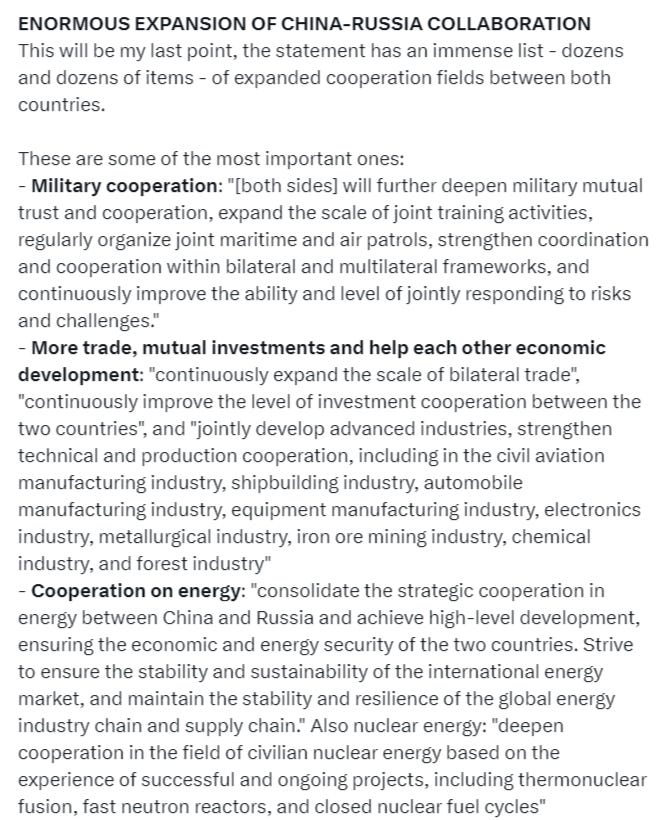

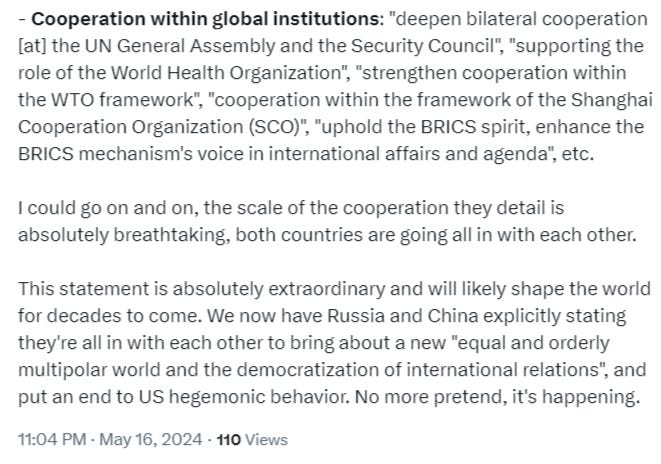


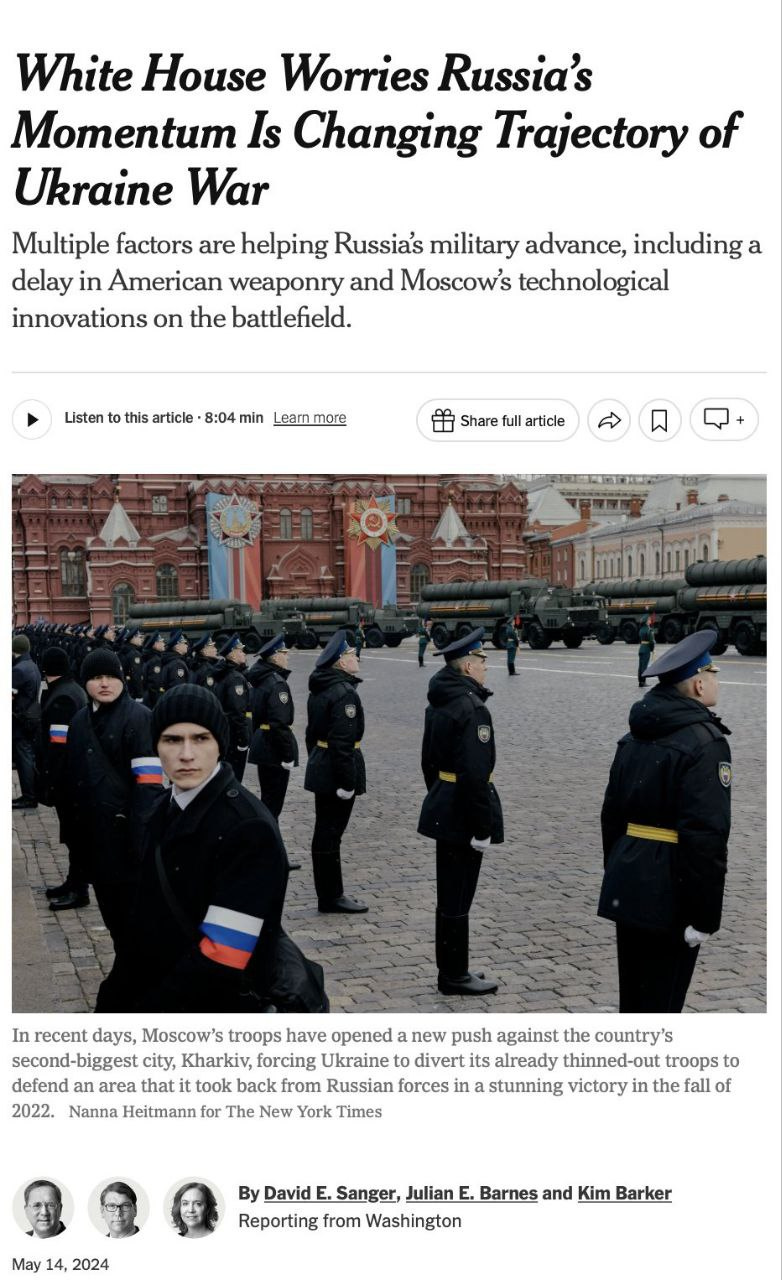
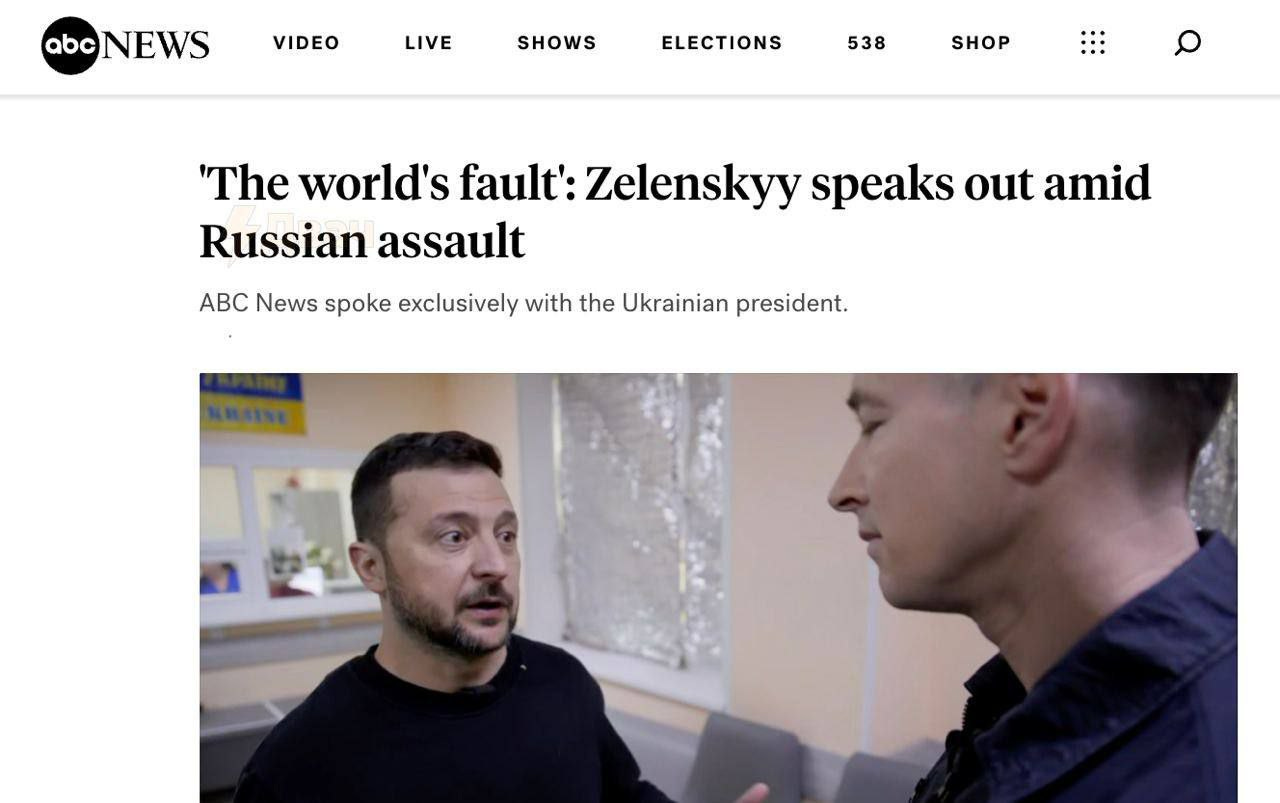
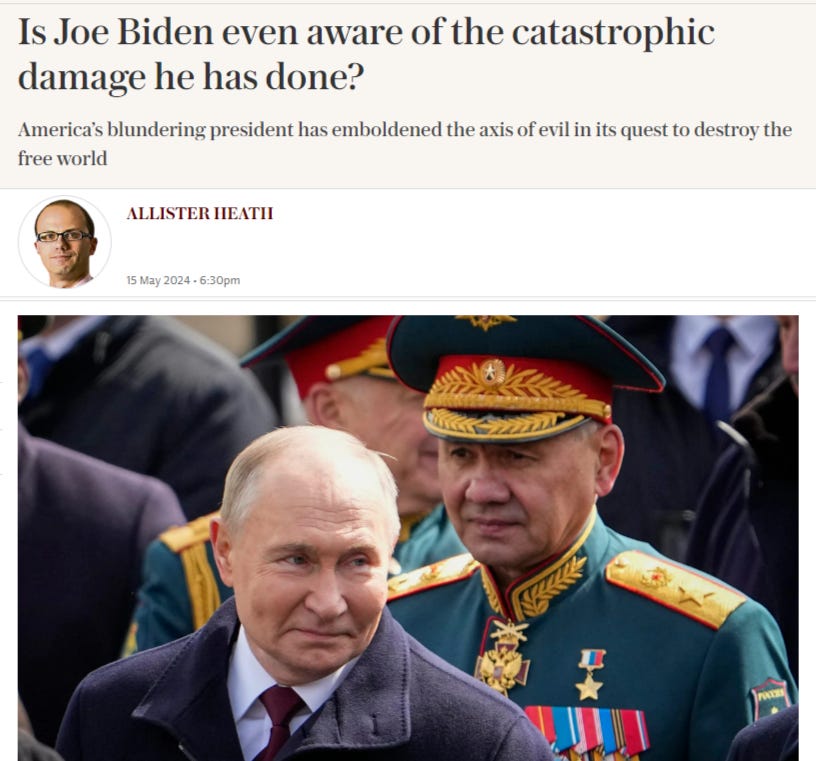
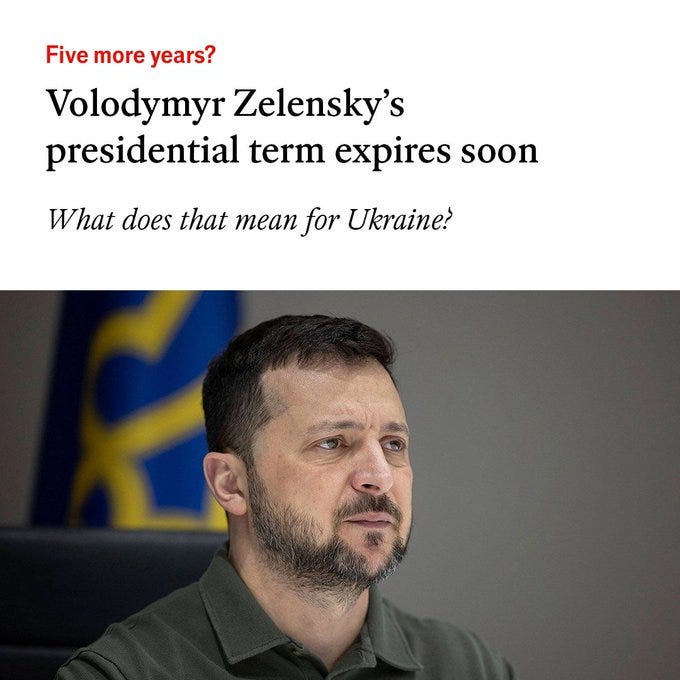
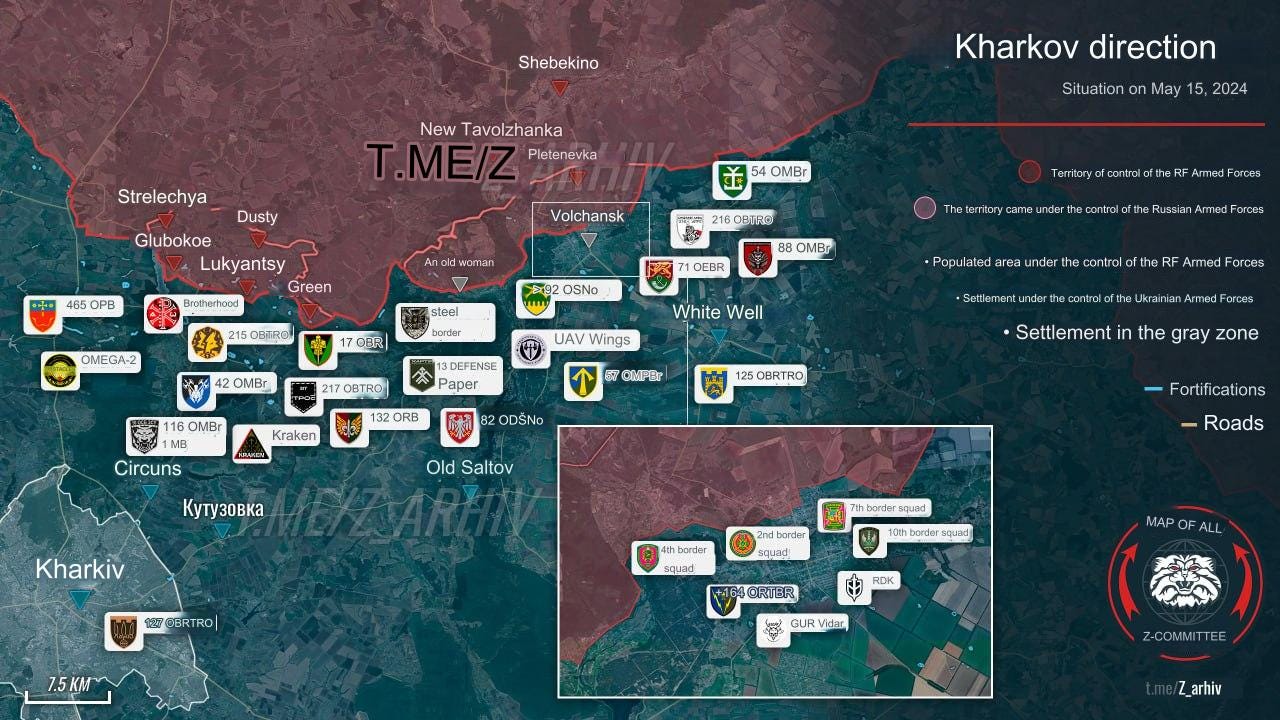
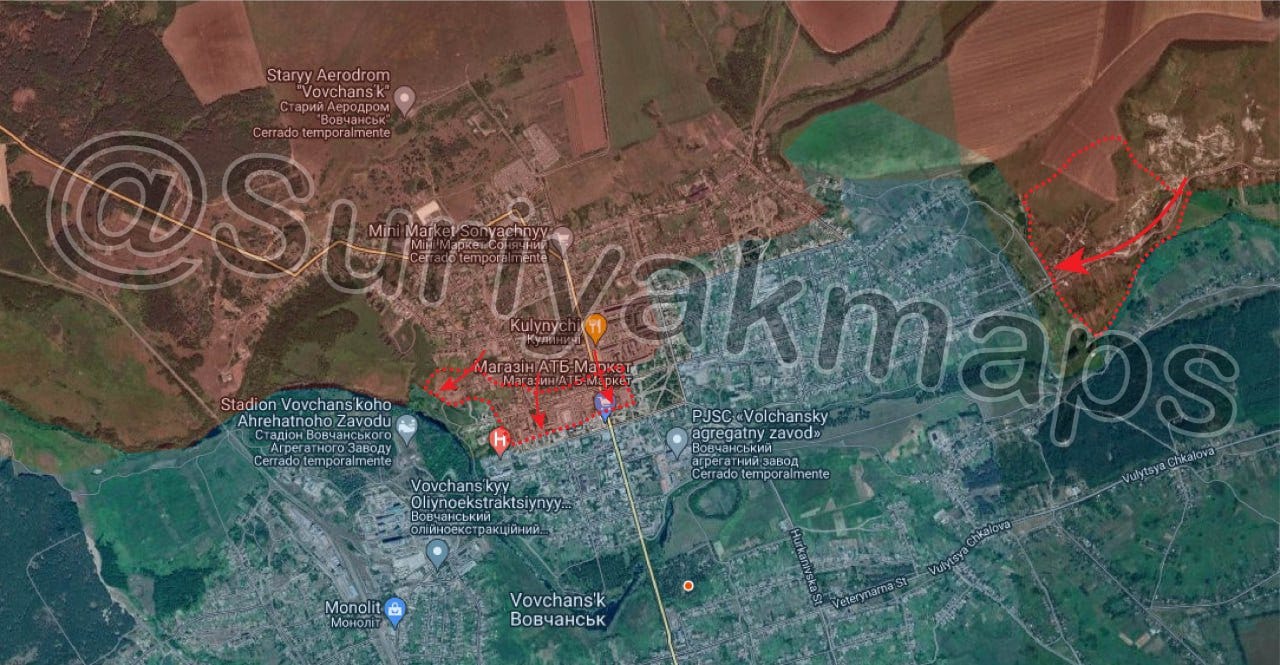
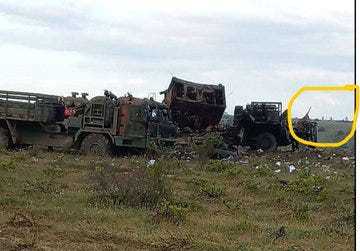
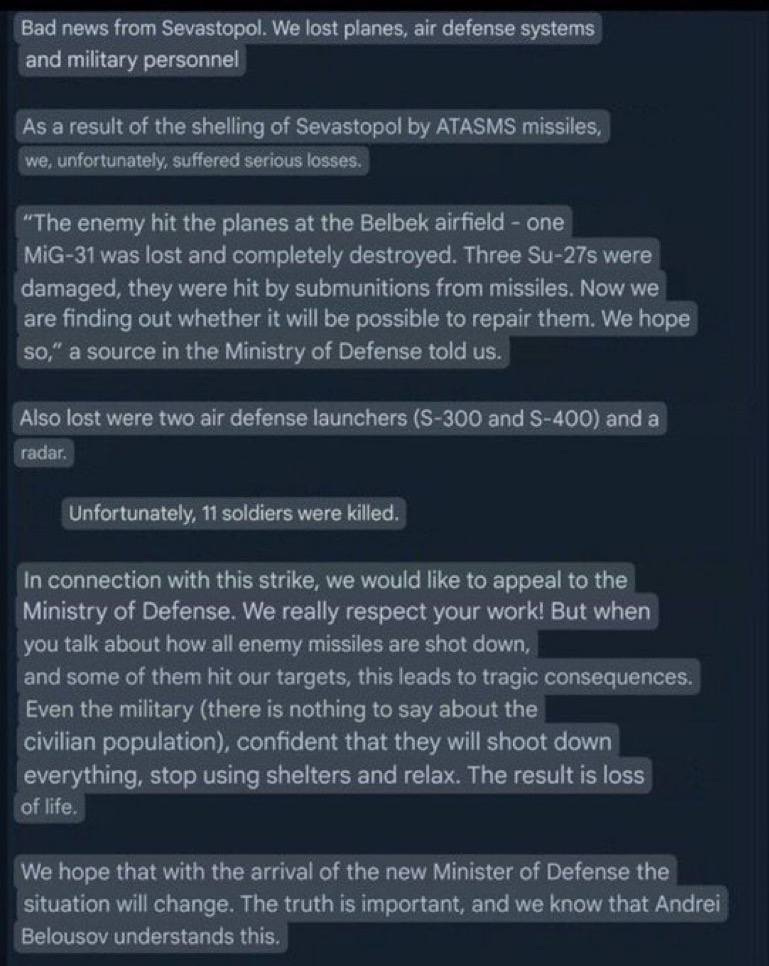
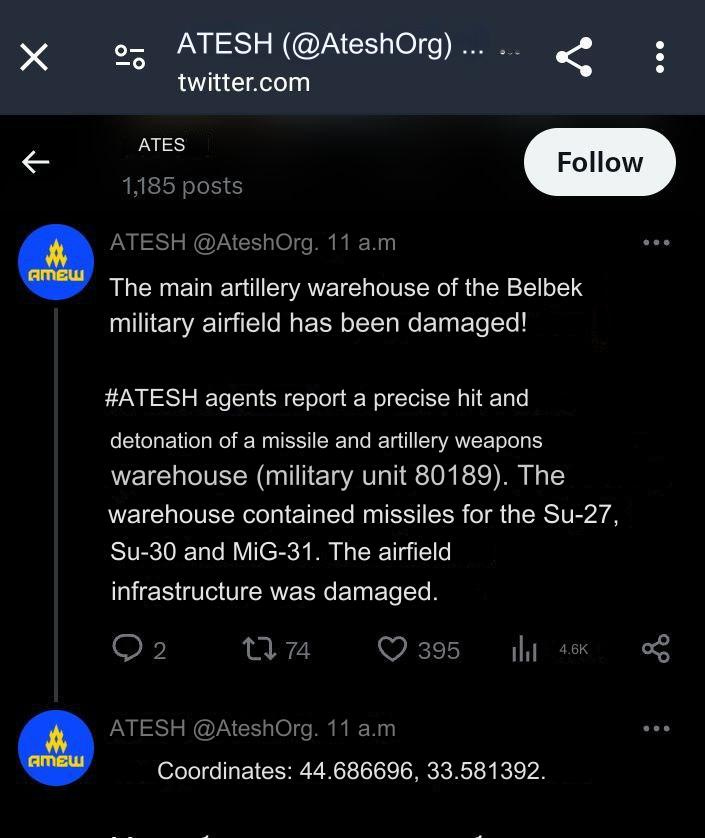
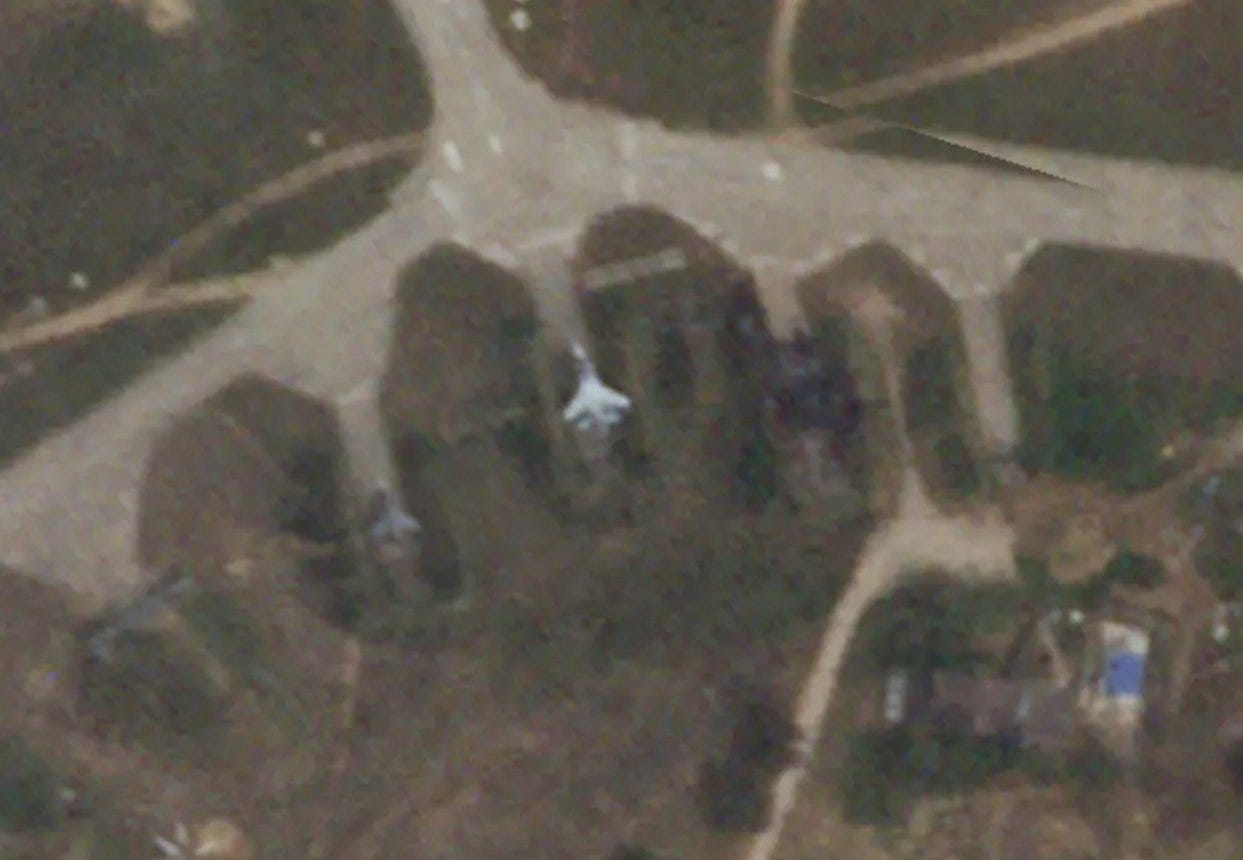
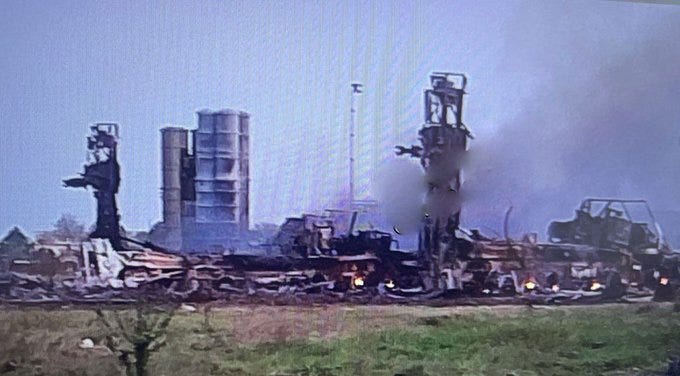
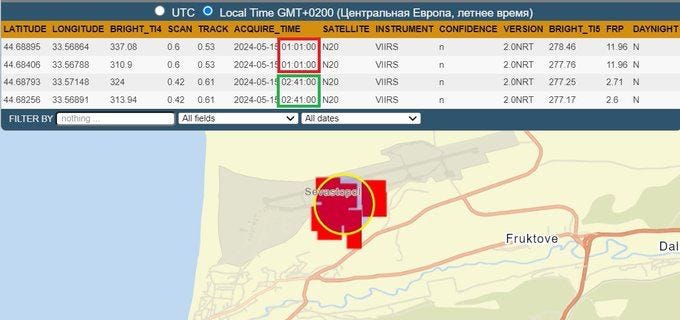
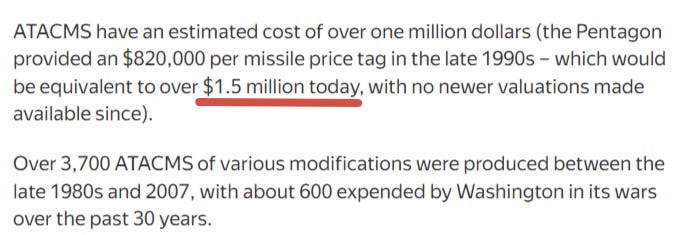


For those who read the article via email, refresh the page as I added some important documents at the top, vis-a-vis the China meeting.
Btw, here is proof of my assertion that Belbek was mostly a defensive base used for surveillance and defending Black Sea rather than any strategic offensive significance. Defense analyst/expert has identified the Mig-31s as NOT Mig-31Ks (which launch Kinzhal missiles) as all pro-UA posters assumed, but rather the defensive Mig-31BM interceptors meant merely to patrol the Black Sea for drones, planes, etc.
https://x.com/GuyPlopsky/status/1791330748945051966